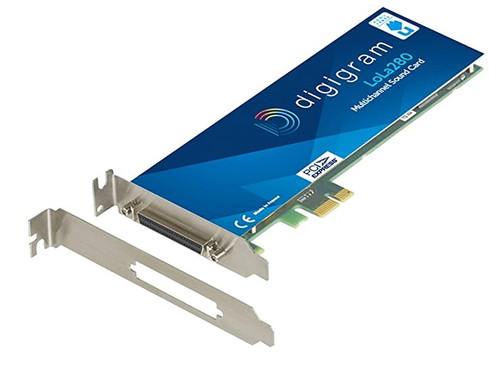Overview
VX1222e MULTICHANNEL PCM SOUND CARD
Multichannel linear PCM sound cards for multichannel playout systems. VX1222e is a broadcast quality linear (PCM) multichannel sound cards based on the PCI Express bus interface. It is designed for use in any professional PC-based audio system running under Windows or Linux and requiring up to six stereo analog and AES/EBU outputs, such as live-assist in broadcast automation.
At a glance
VX1222e is the reference multichannel PCM sound card designed for operating in continuous 24/7/365 use-environments as part of professional audio systems. It can be used under Windows or Linux operating systems, with software applications based on standard driver interfaces such as WDM Kernel streaming, DirectSound, Wasapi, and ASIO for Windows, and Alsa for Linux. It offers six stereo AES/EBU outputs and one stereo AES/EBU input, and can synchronise on an external clock (AES11, Word clock, black burst video).
- Developed for the broadcast industry
- Balanced analog and AES/EBU audio connectivity
- Interoperable with most of the third party software applications for audio production, under Windows and Linux
Key features
- Multichannel linear PCM sound card
- PCI Express bus interface
- Twelve balanced analog outputs and two balanced analog inputs, +24 dBu max level
- Six stereo AES/EBU outputs and one stereo AES/EBU input with hardware sample rate converter
- Synchronisation inputs: AES11, word clock, black burst video
- Adjustable input and output digital gains
- On-board 3-band parametric EQ and Maximizer effects
- Support for Linux (Alsa driver) and Windows 32-bit and 64-bit (WDM kernel streaming, DirectSound, Wasapi, ASIO)
- Audio connectivity: breakout cable or 2U breakout box (BOB12 or BOB16AES), XLR connectors
Specifications
Configuration
- Bus/Format: PCI EXPRESS™ (PCIe®) x1 (x2, x4, x8, x16, x32 compatible)
- Size: 168 mm x 111 mm x 20 mm
- Power requirements (+3.3 V / +12 V): 3 A / 0.4 A
- Operating: temp / humidity (non-condensing): 0°C / +50°C • 5% / 90%
- Storage: temp / humidity (non-condensing): -5°C / +70°C • 0% / 95%
Inputs
- Analog line inputs (mono): 2 balanced
- Maximum input level/ impedance: +24 dBu/ >10 kOhms
- Digital input (stereo): 1 AES/EBU with hw Sample Rate Converter, 7.5:1 to 1:8, up to 192 kHz
- Programmable input gain:
– analog: from –94.5dB to +15.5 dBÄ
– digital: from –110 dB to +18 dB - Other inputs: AES/EBU Sync (up to 192 kHz), Word clock (up to 96 kHz), LTC, Video
- AES11 synchronization
Outputs
- Analog line outputs (mono): 12 servo-balanced
- Maximum output level / impedance: +24 dBu / <100 Ohms
- Digital outputs (stereo): 6 AES/EBU, up to 192 kH
- Programmable output gain:
– analog: from –86 dB to +24 dB
– digital: from –110 dB to +18 d - Other outputs: Word clock (up to 96 kHz)
Connectors
- Internal connectors: Inter-board Sync
- External connector: 68-pin SCSI MDR
- Digigram accessories available: Breakout cable or 2U 19″ Breakout Box
Audio specifications
- Sampling frequencies available: Programmable from 22.05 to 192 kHz
- A/D and D/A converter resolution: 24 bits
- Supported audio formats: PCM (8, 16, 24 bits), Float IEEE754
Audio Performance
- Frequency response (record + play): 20 Hz–20 kHz: ±0.3 dB
- Channel phase difference: 20/20kHz: <0.2°/2°
- Dynamic range (A-weighted):
– analog In: >104 dB
– analog Out: >110 dB - THD + noise 1 kHz at –1 dBfs:
– analog In: <–96 dB
– analog Out: <–96 dB - Crosstalk (Analog in or out):
– 1 kHz at 24 dBu: <–100 dB
– 15 kHz at 24 dBu: <–90 dB
Development environments
- Digigram management under Windows: np SDK
- Other management under Windows: Wave (PCM & MPEG Laye II), WASAPI, ASIO, DirectSound, Alsa (all PCM)
- OS supported: from Windows 7 and Windows server 2003 (32-bit and 64-bit versions), Linux
- Main on-board processing features (with np SDK): PCM play & rec, MPEG Layers I & II play & rec, Layer III play, Float IEEE754,direct monitoring, real-time mixing, level adjustment, panning, cross-fade, punch-in/punch-out, scrubbing, time-stretching, pitch-shifting, 3-band parametric equalizer, maximizer, format and frequency conversions











